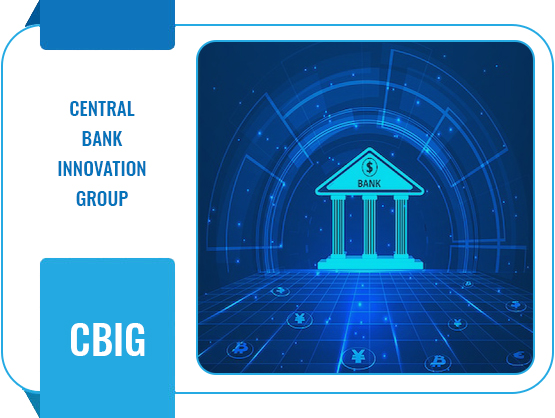
Central Bank Innovation Group (CBIG)
The Central Bank Innovation Group (CBIG) is a specialized research unit within central banks dedicated to exploring and promoting innovation in the financial sector. CBIG’s primary objective is to study emerging trends, technologies, and business models that have the potential to transform the financial industry and to assess their implications for monetary policy, financial stability, and regulatory frameworks.
CBIG’s research interests encompass a wide range of topics at the intersection of finance, technology, and policy. Some of their key areas of focus include:
Central Bank Maturity Models
Central bank maturity models research involves the development and application of frameworks to assess the readiness and capabilities of central banks in adopting and implementing innovative practices, technologies, and policies. These maturity models provide a structured approach for central banks to evaluate their current state, identify areas for improvement, and chart a path toward greater maturity and effectiveness in fulfilling their mandates.

Digital Currencies and Central Bank Digital Currency (CBDC)
CBIG conducts research on digital currencies and their potential impact on monetary policy, financial intermediation, and payment systems. They explore the feasibility and implications of issuing CBDCs, including design considerations, distribution mechanisms, and implications for financial inclusion and stability.
Fintech Innovation and Regulation
CBIG studies the emergence of fintech startups, digital platforms, and innovative financial services such as peer-to-peer lending, crowdfunding, and robo-advisors. They assess the opportunities and challenges posed by fintech innovation, including implications for financial regulation, consumer protection, and market integrity.
Distributed Ledger Technology (DLT) and Blockchain
CBIG researches the applications of distributed ledger technology (DLT) and blockchain in finance, including potential use cases for securities settlement, trade finance, and identity verification. They explore the benefits and challenges of adopting DLT, such as scalability, interoperability, and privacy concerns.
Artificial Intelligence and Machine Learning
CBIG investigates the use of artificial intelligence (AI) and machine learning (ML) in financial services, including algorithmic trading, credit scoring, and risk management. They explore the implications of AI for market efficiency, systemic risk, and financial stability, as well as ethical considerations related to algorithmic decision-making.
Regtech and Supervisory Technology
CBIG studies the development and adoption of regulatory technology (regtech) and supervisory technology (suptech) solutions by central banks and financial regulators. They explore how technology can streamline regulatory compliance, enhance risk assessment, and improve supervision of financial institutions.
Cybersecurity and Resilience
CBIG researches cybersecurity threats and resilience measures in the financial sector, including the protection of critical infrastructure, data privacy, and incident response mechanisms. They collaborate with cybersecurity experts and industry stakeholders to develop best practices and guidelines for mitigating cyber risks.
Open Banking and API Economy
CBIG explores the opportunities and challenges of open banking initiatives and the API (Application Programming Interface) economy. They study the implications of open banking for competition, innovation, and consumer empowerment, as well as data privacy and security concerns.
Financial Inclusion and Digital Literacy
CBIG investigates strategies for promoting financial inclusion and improving digital literacy among underserved populations. They research innovative approaches to expanding access to financial services, such as mobile banking, digital payments, and financial education programs.
International Cooperation and Standards
CBIG collaborates with international organizations, standard-setting bodies, and other central banks to harmonize regulatory approaches, share best practices, and address cross-border challenges in financial innovation. They participate in global initiatives related to fintech regulation, cybersecurity, and CBDC development.
Financial Market Infrastructures (FMIs)
CBIG studies the role of financial market infrastructures, such as central counterparties (CCPs), securities settlement systems, and payment clearing systems, in supporting efficient and resilient financial markets. They research technological innovations and operational enhancements to FMIs, as well as their implications for systemic risk and financial stability.
Quantum Computing and Financial Modeling
CBIG explores the potential applications of quantum computing in financial modeling, risk management, and optimization problems. They research quantum algorithms for portfolio optimization, option pricing, and risk assessment, as well as the implications of quantum computing for cryptography and cybersecurity in finance.
Regulatory Sandboxes and Innovation Hubs
CBIG investigates regulatory sandboxes and innovation hubs as mechanisms for fostering fintech innovation while maintaining regulatory oversight and consumer protection. They research the design and implementation of regulatory sandboxes, lessons learned from sandbox experiments, and approaches for scaling successful innovations.
Central Bank Digital Identity (CBDI)
CBIG examines the concept of central bank digital identity (CBDI) and its potential role in enabling secure and interoperable digital identities for individuals and businesses. They research the technical architecture, privacy-enhancing features, and governance frameworks for CBDI, as well as its applications in digital finance and e-government services.
Smart Contracts and Decentralized Finance (DeFi)
CBIG studies smart contracts and decentralized finance (DeFi) platforms built on blockchain technology. They research the implications of smart contracts for automating financial transactions, programmable money, and the emergence of new decentralized financial services such as decentralized exchanges (DEXs) and lending protocols.
Digital Identity and Know Your Customer (KYC) Processes
CBIG explores digital identity solutions and their potential to streamline KYC processes, enhance customer onboarding, and combat financial crime. They research decentralized identity models, self-sovereign identity frameworks, and interoperable identity verification protocols, as well as regulatory considerations for digital identity adoption.
Financial Market Surveillance and Market Abuse Detection
CBIG studies the use of advanced analytics, machine learning, and natural language processing (NLP) techniques for financial market surveillance and detection of market abuse. They research algorithms for identifying suspicious trading activities, detecting insider trading, and monitoring social media for market manipulation signals.
Monetary Policy and Asset Prices
Researchers examine the relationship between monetary policy actions and asset prices, including stock prices, bond yields, and real estate values. They investigate how changes in interest rates and liquidity conditions influence asset price dynamics, investor behavior, and the risk-taking incentives of financial institutions. Studies also assess the implications of asset price fluctuations for wealth effects, consumption patterns, and financial stability.
Monetary Policy and Economic Uncertainty
Research explores the effects of monetary policy on economic uncertainty and risk perceptions. This includes studying how changes in monetary policy settings, communication, or market expectations affect uncertainty measures such as volatility indices, survey-based uncertainty indicators, and business cycle fluctuations. Researchers analyze the feedback loops between uncertainty, economic decision-making, and monetary policy effectiveness.
Monetary Policy and International Spillovers
Research examines the international transmission of monetary policy shocks and their effects on global financial markets, exchange rates, and economic activity. This includes studying the role of interest rate differentials, capital flows, and currency pegs in transmitting monetary policy impulses across borders. Researchers also assess the effectiveness of coordinated monetary policy actions and international policy coordination mechanisms in addressing global economic challenges.
Monetary Policy and Technological Innovation
With the rise of financial technology (fintech) and digital currencies, researchers explore the implications of technological innovation for monetary policy frameworks and central bank operations. They study the potential benefits and risks of digital currencies, blockchain technology, and distributed ledger systems for payment systems, financial inclusion, and monetary policy transmission. Research also addresses regulatory challenges, cybersecurity risks, and privacy concerns associated with fintech innovation.
Monetary Policy in Emerging Markets and Developing Economies
Studies focus on the unique challenges and policy considerations facing central banks in emerging markets and developing economies. Researchers analyze how factors such as exchange rate regimes, capital mobility, inflation targeting frameworks, and external vulnerabilities affect the conduct and effectiveness of monetary policy in these contexts. They also examine the role of international financial institutions, capital controls, and regional cooperation mechanisms in supporting monetary stability and sustainable development.
Monetary Policy Evaluation and Accountability
Research assesses the performance of monetary policy frameworks and central bank actions against their stated objectives, such as price stability, full employment, and financial stability. Researchers develop quantitative models, econometric techniques, and simulation exercises to evaluate the impact of monetary policy decisions on key macroeconomic variables, including output, inflation, unemployment, and financial market indicators. They also examine central bank communication strategies, policy transparency, and accountability mechanisms to enhance public understanding and trust in monetary policy decisions.
Macroprudential Policy Frameworks
Traditional regulatory approaches focused on microprudential regulation, which primarily addresses risks at the level of individual financial institutions. In contrast, macroprudential regulation considers systemic risks that could threaten the stability of the entire financial system. Innovations in macroprudential policy frameworks involve the development of tools and instruments to monitor and address systemic risks, such as leverage limits, capital buffers, loan-to-value ratios, and countercyclical capital requirements. These tools aim to dampen procyclical behavior, prevent the buildup of systemic vulnerabilities, and enhance the resilience of the financial system as a whole.
Stress Testing and Scenario Analysis
Stress testing has become a key tool for assessing the resilience of financial institutions and the broader financial system to adverse shocks. Innovations in stress testing methodologies involve the development of more sophisticated scenario analysis, incorporating a wider range of macroeconomic variables, market stressors, and interconnected risks. Scenario analysis enables regulators to assess the potential impact of severe but plausible scenarios on financial institutions’ capital adequacy, liquidity, and solvency, thereby informing supervisory actions and policy responses to mitigate systemic risks.
Systemic Risk Assessment and Early Warning Systems
Innovations in systemic risk assessment involve the development of early warning systems and risk indicators to identify emerging threats to financial stability. These systems use a combination of quantitative models, data analytics, and qualitative assessments to monitor key risk factors, such as asset price bubbles, excessive leverage, interconnectedness, and contagion risks. Early warning systems provide policymakers and regulators with timely signals of potential systemic vulnerabilities, enabling preemptive actions to mitigate risks before they escalate into crises.
Network Analysis and Contagion Risk Management
Network analysis has emerged as a powerful tool for understanding the interconnectedness and contagion risks within the financial system. Innovations in network analysis involve the use of complex network theory, graph theory, and machine learning algorithms to model and analyze the interdependencies among financial institutions, markets, and infrastructures. Network analysis enables regulators to identify systemically important institutions, assess the potential pathways of contagion, and design targeted interventions to mitigate systemic risks and enhance financial resilience.
Overall, CBIG’s research agenda is driven by a commitment to fostering a safe, efficient, and inclusive financial system through responsible innovation and evidence-based policymaking. By staying at the forefront of technological advancements and market developments, CBIG aims to support central banks in fulfilling their mandates and maintaining financial stability in an increasingly digital and interconnected world.
